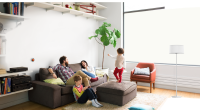More and more home builders say they’re looking to try new products this year, says a recent BUILDER magazine survey. A likely candidate on that new product list is connected home technology, such as a smart thermostat.
Smart, WiFi-enabled thermostats made their market entrance back in 2011. The devices quickly caught on as upgrade items for homeowners looking to cut energy costs.
Home builders for the most part, have been more reserved with acceptance. The memories of over-promised, under-performing home automation technology offered earlier in the decade still lingers with many in the trade.
Differentiator
A recent experience with Cortland Partners, LLC, one of the nation’s largest multifamily organizations, may help change that thinking.
The Atlanta-based company owns and manages over 40,000 apartments across 100 U.S. communities. Their emphasis on “going beyond expectations” is a key differentiator in their rise in industry rankings.
Cortland Partners understands how amenities attract and retain residents so they constantly investigate new amenities. They recently discovered the Nest Learning Thermostat is “hands down is the best received amenity we’ve ever added,” according to Jonathan Tucker, executive vice president of Cortland facilities and services.
The company teamed up with Nest, an Alphabet company, to install Nest Learning Thermostats in 15,000 units around the country in late 2016. Sarah DeFrancis, Cortland director of branding, admits she was concerned about the resident reception, in spite of the success of an internal pilot program.
“I was concerned people were going to push back,” she explains. “We didn’t want people to think we were infringing upon them and making their lives more difficult.”
Tucker and DeFrancis identified three reasons that may have contributed to the overwhelmingly positive reception:
- A brand name that people know and respect
- User-friendly technology that is easy to understand and operate
- Real, measurable energy-saving benefits*
Builder Lesson?
For home builders considering a move into connected home technology, the Cortland experience can be seen as a lesson on what to expect on a home-by-home basis.
“We monitor all of our residents’ satisfaction levels,” Tucker says. “That launch did wonders for our satisfaction levels. I was surprised at just how well it was received. I know there are many different smart thermostats out there. For whatever reason, this one really, really excited our residents.”
It’s a measure of the rollout’s success that it now serves as a performance yardstick for the company. “We’ve actually started looking at other technology products. This experience is now the litmus test.
“It’s hard to say if this win was because of the name or product performance. Whatever it was, it has been definitely beneficial to us.” For more information, visit here.
*Independent studies showed that Nest saved people an average of 10% to 12% on heating and 15% on cooling. Individual savings are not guaranteed.



